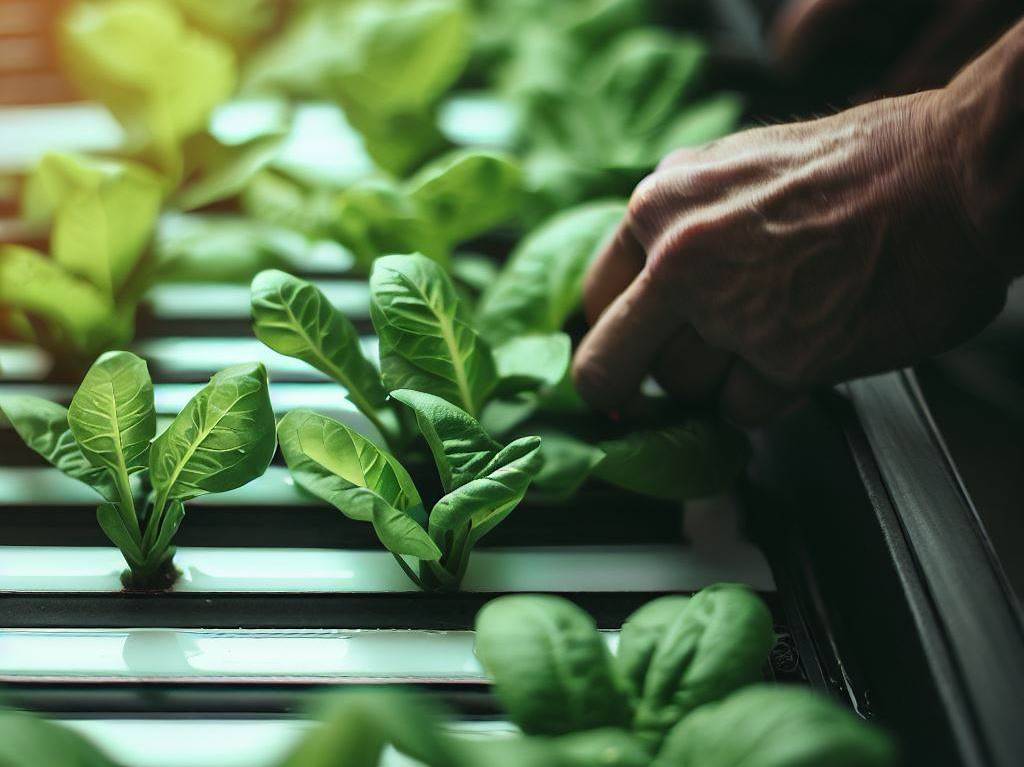Are you curious about whether spinach can be grown in an aquaponics system? Given its popularity and health benefits, many are turning to growing this leafy green at home. This blog post will guide you through the process, providing tips and methods for successfully cultivating spinach in an aquaponic environment.
Can you grow spinach in aquaponics?
You can successfully grow spinach in an aquaponics system year-round. Various methods like Deep Water Culture, Flood and Drain, and Vertical Farming can be used. Key factors for successful growth include maintaining a temperature of 15-20°C, ensuring 10-12 hours of sunlight, keeping pH levels between 6.5 and 7.0, and using clean, contaminant-free water. The system is beneficial for water conservation and provides high nutritional value. Challenges like germination issues and nutrient deficiencies can be managed with proper care.
Stick around if you’re looking for a sustainable way to enjoy fresh, home-grown spinach all year round!
Key Takeaways
- Spinach can be successfully grown in aquaponics systems, providing a year – round supply of fresh and nutritious leafy greens.
- Aquaponics offers several benefits for growing spinach, including water conservation and the ability to control temperature and lighting conditions for optimal growth.
- Different methods can be used to grow spinach in aquaponics, such as the Deep Water Culture method, Flood and Drain Media-based Aquaponics, and Vertical Aquaponics Farming.
- Factors to consider for successful spinach growth include temperature requirements (around 15°C to 20°C), sunlight exposure (10 to 12 hours per day), pH levels (6.5 to 7.0), and water quality (free from contaminants).
Benefits of Growing Spinach in Aquaponics

Growing spinach in aquaponics offers several benefits, including its high nutritional value and the ability to have a year-round supply of fresh spinach.
Nutritional value
Spinach packs a punch when it comes to nutrients. This super green is full of vitamins and minerals. It has vitamin A, C and K. It also has folate, which helps make new cells in your body.
To keep our muscles strong, spinach gives us protein and iron too! When it grows in an aquaponics system, it keeps all these great things. So the next time you enjoy some home-grown aquaponic spinach, know that you are feeding your body with lots of good stuff!
Year-round availability
Spinach is a leafy green that can be grown in aquaponics systems all year round. Unlike traditional gardening where you are limited by the seasons, aquaponics provides a controlled environment for spinach growth.
This means you can enjoy fresh and healthy spinach throughout the year, regardless of the weather outside. With proper temperature and lighting adjustments, you can create an ideal growing condition for your spinach plants in aquaponics.
This availability ensures a constant supply of nutritious greens for you to enjoy without worrying about seasonal limitations or shortages.
Water conservation
In aquaponics, water conservation is a key benefit. Unlike traditional gardening methods that require large amounts of water, aquaponics systems recycle and reuse water efficiently.
The fish waste in the system provides nutrients for the plants, while the plants help filter and clean the water for the fish. This closed-loop system significantly reduces water usage compared to soil-based agriculture.
With aquaponics, you can grow spinach while conserving water resources and promoting sustainable farming practices.
Methods for Growing Spinach in Aquaponics

There are several methods for growing spinach in aquaponics, including the Deep Water Culture (D.W.C.) method, Flood and Drain Media-based Aquaponics, and Vertical Aquaponics Farming.
Deep Water Culture (D.W.C.) method
One popular method for growing spinach in aquaponics is the Deep Water Culture (D.W.C.) method. This technique involves suspending the spinach plants’ roots directly in nutrient-rich water, allowing them to absorb the necessary nutrients and oxygen.
In this system, a container or tray holds the plants above a reservoir of water enriched with fish waste. An air pump provides oxygen to both the roots and fish. By using this method, you can easily monitor and control the nutrient levels and pH of the water, ensuring ideal conditions for your spinach plants to thrive.
Flood and Drain Media-based Aquaponics

Flood and Drain Media-based Aquaponics is a popular method for growing spinach in aquaponics systems. In this method, a media bed filled with grow media, such as gravel or expanded clay pebbles, is used to support the spinach plants.
The system works by periodically flooding the grow bed with nutrient-rich water from the fish tank and then draining it back into the tank. This cycle provides the plants with a constant supply of water and nutrients while also improving oxygen circulation around the roots.
One advantage of using Flood and Drain Media-based Aquaponics for growing spinach is that it allows for better control over moisture levels in the root zone. The periodic flooding ensures that the spinach plants receive sufficient water without becoming oversaturated.
Additionally, the grow media acts as a filter, helping to remove solid waste particles from the water before it returns to the fish tank.
This method also supports beneficial bacteria growth within the grow media, which helps convert fish waste into essential nutrients for plant growth. Spinach plants grown in flood and drain aquaponic systems tend to thrive due to their shallow root structure and preference for cooler temperatures.
Vertical Aquaponics Farming
Vertical aquaponics farming is a method of growing spinach that maximizes space utilization. In this technique, plants are grown in vertical towers or shelves, allowing for more efficient use of available area.
With the help of nutrient-rich water from the fish tank, the plants receive essential nutrients necessary for their growth. Vertical aquaponics farming also provides adequate sunlight exposure to each plant, ensuring their proper development.
This approach not only saves space but also allows for easy access and maintenance of the crops.
Factors to Consider for Successful Spinach Growth

Temperature requirements, sunlight exposure, pH levels, and water quality are all important factors to consider for successful spinach growth in aquaponics. Read on to learn more about how to optimize these factors for a thriving spinach crop.
Temperature requirements
Spinach requires specific temperature conditions to thrive in aquaponics. It prefers cooler temperatures, around 15°C to 20°C, making it well-suited for this system. The water temperature should be maintained within the range of 18°C to 21°C for successful germination of spinach seeds.
Cooler temperatures help the plants grow healthier and produce better yields. It is important to monitor and control the temperature in your aquaponics setup to create an ideal environment for growing spinach.
By providing the right temperature conditions, you can maximize the growth and health of your spinach plants in aquaponics.
Sunlight exposure
Spinach plants grown in aquaponics systems need a good amount of sunlight. They require about 10 to 12 hours of sunlight every day for healthy growth. Sunlight provides the energy needed for photosynthesis, which is how plants make food and grow.
Without enough sunlight, spinach plants may become weak and pale in color. So, it’s important to place your aquaponics system in a spot where it can get plenty of direct sunlight throughout the day.
pH levels
Maintaining the right pH levels is crucial for growing spinach in aquaponics. Spinach plants prefer a slightly acidic to neutral pH range of 6.5 to 7.0. This ensures that the nutrients are readily available to the plants and they can absorb them effectively.
Regularly monitor the pH level of your aquaponics system using a testing kit or meter, and make adjustments if necessary by adding pH adjusters like potassium hydroxide or phosphoric acid.
Keeping the pH within the ideal range will help promote healthy spinach growth and maximize nutrient uptake from the water.
Water quality
The quality of water is crucial for growing spinach in aquaponics. The water should be clean and free from contaminants to ensure healthy plant growth. It’s important to monitor the pH levels of the water to maintain an optimal range of 6.5 to 7.
Fish waste, which serves as a nutrient source for plants, can increase the ammonia levels in the water if not properly managed. This can harm both the fish and plants. Regular testing of water parameters such as ammonia, nitrite, and nitrate levels is essential for maintaining a balanced ecosystem.
Additionally, using a filtration system or adding beneficial bacteria can help in maintaining good water quality by breaking down harmful compounds and improving nutrient availability for spinach plants.
Common Challenges and Solutions

Germination issues can occur when growing spinach in aquaponics, but can be overcome by providing the seeds with proper moisture and temperature conditions.
Germination issues
Germination can sometimes be a challenge when growing spinach in aquaponics. Spinach seeds need the right conditions to sprout and grow into healthy seedlings. One common issue is improper temperature during germination, as spinach seeds prefer temperatures between 18°C to 21°C.
Another factor that affects germination is seed quality, so it’s important to use fresh and viable spinach seeds for best results. Additionally, if the seeds are not properly cleaned before planting, they may contain inhibitors that prevent germination.
However, with proper care and attention to these factors, you can overcome germination issues and ensure successful growth of your spinach in aquaponics systems.
Nutrient deficiencies
Nutrient deficiencies can sometimes occur when growing spinach in aquaponics. Since the plants rely on the nutrients provided by the fish waste, it’s important to maintain a balanced system.
One common deficiency is a lack of iron, which can cause yellowing leaves. To address this, you can add chelated iron to the water or increase the pH level slightly. Another potential issue is a lack of nitrogen, which may result in stunted growth and pale leaves.
This can be remedied by feeding the fish more protein-rich food or adding additional sources of nitrogen to the system, such as seaweed extract or fish emulsion. Monitoring nutrient levels regularly will help ensure that your spinach plants receive all the necessary nutrients for healthy growth.
Pests and diseases
Spinach grown in aquaponics systems is generally less susceptible to pests and diseases compared to traditional soil-based gardening. However, there are still some potential challenges to be aware of.
Spider mites can occasionally infest spinach plants, causing yellowing leaves and webbing. To prevent this, regular inspection and spraying the plants with water can help keep them at bay.
Aphids may also be a concern, but they can be controlled by using natural predators like ladybugs or by washing the affected leaves thoroughly. As for diseases, spinach can sometimes suffer from fungal infections such as powdery mildew or downy mildew.
Conclusion
In conclusion, growing spinach in aquaponics is a fruitful and easy process. With the right care and conditions, you can enjoy a bountiful harvest of nutrient-rich leafy greens year-round.
So go ahead and give it a try – your taste buds and health will thank you!
FAQs
1. Can you grow spinach in aquaponics?
Yes, growing leafy greens like spinach in aquaponics is possible and it’s a part of no soil gardening.
2. What is the process for planting spinach seeds in an Aquaponics system?
Spinach care includes germinating spinach seedlings first, then planting them into your aquaponic garden without soil or with hydroponic methods.
3. How do we do Aquaponics fish to plant ratio while growing Spinach?
The success factors for growing spinach in aquaponics include proper fish to plant ratio which helps maintain nutrient cycling and ensures healthy growth.
4. Are there any tips on how to deal Spinach harvest and maximize yield using Aquaponics?
Yes, certain gardening methods can help you get more from your crop rotation when harvesting your organic, hydroponically grown leafy greens including maximizing yield with proper nutrients.
5. Does eating fish from my Spinach-focused aquaponic system affect its productivity?
No! The driving force behind sustainable agriculture like vertical farming is having the correct balance between crops and aquatic life such as fishes.

As a dedicated mother and passionate software developer, she weaves her diverse experiences into captivating stories that inspire and engage readers. Emma's love for sustainable living and environmental consciousness permeates both her personal and professional life. When she's not immersed in the world of coding and software development, Emma can be found nurturing her family and tending to her thriving organic garden. Her commitment to sustainable practices extends to every aspect of her life, from repurposing household items to embracing eco-friendly technologies.










